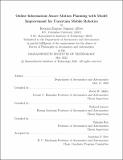Online Information-Aware Motion Planning with Model Improvement for Uncertain Mobile Robotics
Author(s)
Albee, Keenan Eugene Sumner
DownloadThesis PDF (68.75Mb)
Advisor
Miller, David W.
Linares, Richard
Roy, Nicholas
Terms of use
Metadata
Show full item recordAbstract
Mobile robots increasingly interact with unstructured, uncertain environments while performing useful tasks. To navigate their surroundings these robots rely on models of their own motion which themselves might not be perfectly known. Some of these uncertainties are considered within the context of the model, like unknown inertial properties; others are simply considered beyond the model's fidelity and are treated as disturbance terms.
Accounting for these uncertainties when performing robotic motion planning provides a richer approximation of reality, unlocking tools such as robustness or chance-constrained safety guarantees, improving motion planning optimality, and more. However, the current literature largely divides between approaches which are purely robust (or probabilistically robust) and those which consider motion planning's ability to gather information but without robustness. Moreover, these information-aware approaches rarely consider information content about the robot's own system model. Both robustness and information-awareness are desirable and can even be complementary: model information gained online is useful for performing model improvement that can aid in replanning and adjusting robustness guarantees on-the-fly. However, model-improving motion planning methods that are real-time, online-updateable, and with robustness guarantees are lacking.
This thesis bridges the research gap of creating online model information-aware motion planning with control robustness guarantees. A motion planning algorithm, RATTLE, is introduced consisting of an online-updateable planning and control hierarchy capable of receiving model updates en route. Model parametric information-aware local planning and a robust online-updateable control strategy are demonstrated, as well as techniques to interpret model uncertainty and to guide the learning tradeoff.
This approach can be particularly appealing for space robotic systems which demand safe execution but which also desire optimal, fuel-conserving solutions. As such, two space close proximity operations use cases serve as guiding scenarios to demonstrate the capabilities of RATTLE: microgravity cargo maneuvering and autonomous on-orbit rendezvous with uncertain tumbling targets. A fully-fledged autonomous rendezvous framework, TRACE, is introduced in the context of RATTLE for the latter scenario. Simulation and on-orbit results on the International Space Station are presented for both scenarios using the Astrobee robotic free-flyers, highlighting each's uncertainty sources, the benefits of information-aware planning, and real-time resource-constrained hardware performance. The first known fully autonomous rendezvous with an uncertain tumbling target and the first known microgravity information-aware planning demonstration are conducted on-orbit. Tying together RATTLE's contributions, these results provide a concrete, hardware implementation example of the benefits and challenges of online information-aware planning coupled with model updating for mobile robotic systems operating with various uncertainty sources.
Date issued
2022-05Department
Massachusetts Institute of Technology. Department of Aeronautics and AstronauticsPublisher
Massachusetts Institute of Technology